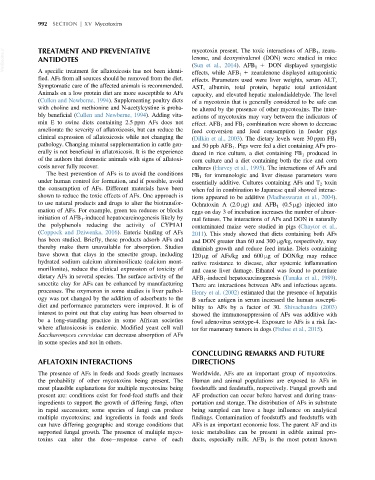Page 1060 - Veterinary Toxicology, Basic and Clinical Principles, 3rd Edition
P. 1060
992 SECTION | XV Mycotoxins
VetBooks.ir TREATMENT AND PREVENTATIVE mycotoxin present. The toxic interactions of AFB 1 ,zeara-
lenone, and deoxynivalenol (DON) were studied in mice
ANTIDOTES
(Sun et al., 2014). AFB 1 1 DON displayed synergistic
A specific treatment for aflatoxicosis has not been identi-
fied. AFs from all sources should be removed from the diet. effects, while AFB 1 1 zearalenone displayed antagonistic
effects. Parameters used were liver weights, serum ALT,
Symptomatic care of the affected animals is recommended. AST, albumin, total protein, hepatic total antioxidant
Animals on a low protein diet are more susceptible to AFs capacity, and elevated hepatic malondialdehyde. The level
(Cullen and Newberne, 1994). Supplementing poultry diets of a mycotoxin that is generally considered to be safe can
with choline and methionine and N-acetylcystine is proba- be altered by the presence of other mycotoxins. The inter-
bly beneficial (Cullen and Newberne, 1994). Adding vita- actions of mycotoxins may vary between the indicators of
min E to swine diets containing 2.5 ppm AFs does not effect. AFB 1 and FB 1 combination were shown to decrease
ameliorate the severity of aflatoxicosis, but can reduce the feed conversion and feed consumption in feeder pigs
clinical expression of aflatoxicosis while not changing the
(Dilkin et al., 2003). The dietary levels were 30 ppm FB 1
pathology. Changing mineral supplementation in cattle gen- and 50 ppb AFB 1 . Pigs were fed a diet containing AFs pro-
erally is not beneficial in aflatoxicosis. It is the experience duced in rice culture, a diet containing FB 1 produced in
of the authors that domestic animals with signs of aflatoxi- corn culture and a diet containing both the rice and corn
cosis never fully recover. cultures (Harvey et al., 1995). The interactions of AFs and
The best prevention of AFs is to avoid the conditions FB 1 for immunologic and liver disease parameters were
under human control for formation, and if possible, avoid essentially additive. Cultures containing AFs and T 2 toxin
the consumption of AFs. Different materials have been when fed in combination to Japanese quail showed interac-
shown to reduce the toxic effects of AFs. One approach is tions appeared to be additive (Madheswaran et al., 2004).
to use natural products and drugs to alter the biotransfor- Ochratoxin A (2.0 μg) and AFB 1 (0.5 μg) injected into
mation of AFs. For example, green tea reduces or blocks eggs on day 3 of incubation increases the number of abnor-
initiation of AFB 1 -induced hepatocarcinogenesis likely by mal fetuses. The interactions of AFs and DON in naturally
the polyphenols reducing the activity of CYP1A1 contaminated maize were studied in pigs (Chaytor et al.,
(Coppock and Dziwenka, 2016). Enteric binding of AFs 2011). This study showed that diets containing both AFs
has been studied. Briefly, these products adsorb AFs and and DON greater than 60 and 300 μg/kg, respectively, may
thereby make them unavailable for absorption. Studies diminish growth and reduce feed intake. Diets containing
have shown that clays in the smectite group, including 120 μg of AFs/kg and 600 μg of DON/kg may reduce
hydrated sodium calcium aluminosilicate (calcium mont- native resistance to disease, alter systemic inflammation
morillonite), reduce the clinical expression of toxicity of and cause liver damage. Ethanol was found to potentiate
dietary AFs in several species. The surface activity of the AFB 1 -induced hepatocarcinogenesis (Tanaka et al., 1989).
smectite clay for AFs can be enhanced by manufacturing There are interactions between AFs and infectious agents.
processes. The oxymoron in some studies is liver pathol- Henry et al. (2002) estimated that the presence of hepatitis
ogy was not changed by the addition of adsorbents to the B surface antigen in serum increased the human suscepti-
diet and performance parameters were improved. It is of bility to AFs by a factor of 30. Shivachandra (2003)
interest to point out that clay eating has been observed to showed the immunosuppression of AFs was additive with
be a long-standing practice in some African societies fowl adenovirus serotype-4. Exposure to AFs is a risk fac-
where aflatoxicosis is endemic. Modified yeast cell wall tor for mammary tumors in dogs (Frehse et al., 2015).
Saccharomyces cerevisiae can decrease absorption of AFs
in some species and not in others.
CONCLUDING REMARKS AND FUTURE
AFLATOXIN INTERACTIONS DIRECTIONS
The presence of AFs in feeds and foods greatly increases Worldwide, AFs are an important group of mycotoxins.
the probability of other mycotoxins being present. The Human and animal populations are exposed to AFs in
most plausible explanations for multiple mycotoxins being foodstuffs and feedstuffs, respectively. Fungal growth and
present are: conditions exist for food-feed stuffs and their AF production can occur before harvest and during trans-
ingredients to support the growth of differing fungi, often portation and storage. The distribution of AFs in substrate
in rapid succession; some species of fungi can produce being sampled can have a huge influence on analytical
multiple mycotoxins; and ingredients in foods and feeds findings. Contamination of foodstuffs and feedstuffs with
can have differing geographic and storage conditions that AFs is an important economic loss. The parent AF and its
supported fungal growth. The presence of multiple myco- toxic metabolites can be present in edible animal pro-
toxins can alter the dose response curve of each ducts, especially milk. AFB 1 is the most potent known

